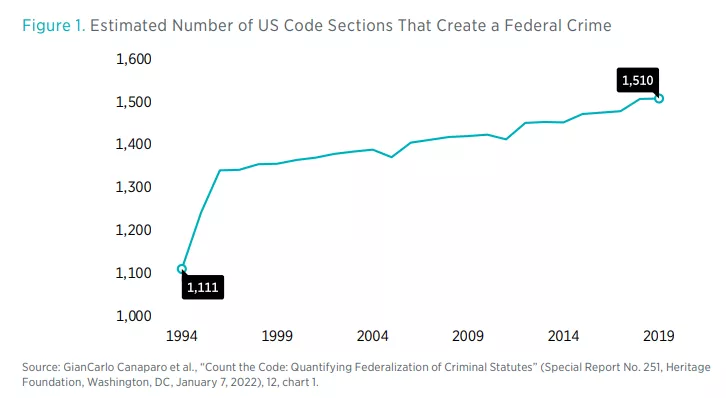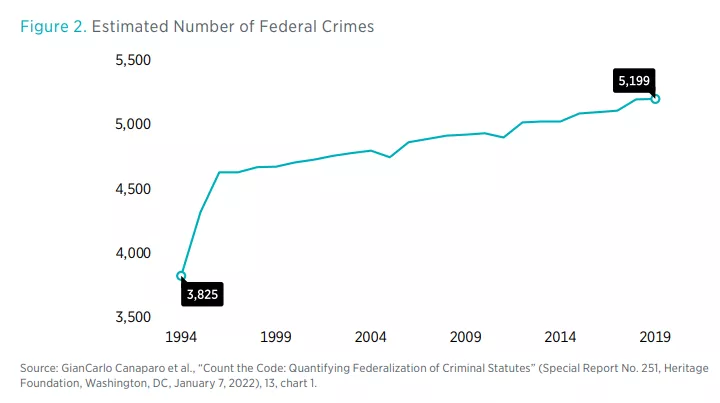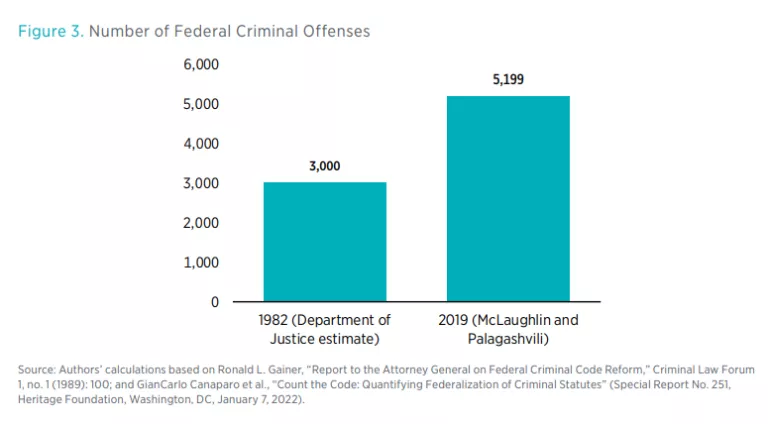- | Regulation Regulation
- | Policy Briefs Policy Briefs
- |
Counting the Code: How Many Criminal Laws Has Congress Created?
Putting a number on the total federal criminal laws created by Congress is a challenging task. There is no single place where any citizen can go to learn what is a federal crime and how many such crimes exist. A new study attempts to alleviate this problem by estimating the total number of federal crimes and measuring the year-by-year growth in the federalization of crime in the United States.
“Count the Code: Quantifying Federalization of Criminal Statutes” uses a text analysis algorithm that now makes it possible to assess the growth of the ever-expanding federal criminal code.1 The study uses the following 12 carefully selected search terms to sift the US Code’s approximately 48,000 sections (spread across tens of thousands of pages) to identify which statutes create at least one crime:
- “Shall be fined under this title, imprisoned”
- “Be fined under this title or imprisoned”
- “Imprisonment for not more than”
- “Sentenced to imprisonment or death”
- “Be fined not more than”
- “Imprisoned not more than”
- “Be punished by a fine”
- “Shall be fined or imprisoned”
- “Shall be fined”
- “Shall be punished”
- “Imprisoned for not more than”
- “Shall be guilty of”
CHARTING THE GROWTH OF THE FEDERAL CRIMINAL CODE
The federalization of crime has long been a concern among the legal community, which has suspected that Congress has been encroaching on matters that were traditionally left to the states. In attempting to measure this takeover, in 1998, the American Bar Association concluded that “whatever the exact number of crimes that comprise today’s ‘federal criminal law,’ it is clear that the amount of individual citizen behavior now potentially subject to federal criminal control has increased in astonishing proportions in the last few decades.”
Today, 1,510 sections of the US Code create crimes. That number has steadily increased, growing by about 36 percent since 1994, when the total was 1,111. That’s an overall growth rate of 1.27 percent per year. Figure 1 illustrates this increase in the number of criminal sections over time.
“Count the Code” also provides an estimate of the number of federal crimes in existence each year. In 1994 there were 3,825 federal crimes; by 2019 that number had increased by more than a third, to 5,199. Figure 2 shows the study’s estimated number of crimes on the books for each year in the study.
The sharpest increases in federal crimes came between 1994 and 1995 (12 percent) and between 1995 and 1996 (8 percent). Those rises account for more than half of the total growth in the entire 22-year period.


In 1982, the US Department of Justice launched the first major attempt to manually count the number of criminal laws that Congress had created. It found approximately 3,000. Although the method used in “Count the Code” differs, it can still estimate that between 1982 and 2019 the number of federal criminal offenses increased by 73 percent (see figure 3).
Significant as these increases are, the true number of federal crimes is actually much higher. That’s because numerous others are created through regulations promulgated by federal agencies rather than by Congress. Those additional crimes reside in a different (and much longer) set of books than the US Code—the similarly titled US Code of Federal Regulations. That document runs to 175,000 pages, and the number of crimes it contains is unknown.

TURNING AVERAGE AMERICANS INTO CRIMINALS?
“It will be of little avail to the people, that the laws are made by men of their own choice, if the laws be so voluminous that they cannot be read, or so incoherent that they cannot be understood.” So declared James Madison in 1788. Nearly two and a half centuries later the confusion surrounding the scope and size of federal crimes threatens to leave Americans not just confused, but guilty.
Some federal crimes are so vague that no reasonable person can know what they mean. For instance, in some cases it’s a federal crime to violate the laws of foreign countries. Other laws forbid behavior that no one exercising ordinary good judgement would ever expect to be crimes. According to one estimate, the situation is so serious that every American unknowingly commits three felonies a day.
“Count the Code” is a necessary first step in addressing this growing problem. It provides a way to consider which “crimes” could send Americans to jail for accidents, innocent mistakes, or violations that do not warrant years behind bars. Subsequent steps can address a further range of issues related to the expansion of federal crimes.
OTHER QUESTIONS TO BE ADDRESSED
The data in “Count the Code” can be used with other datasets to explore key questions related to government and crime. They include the following:
- What is the extent of redundancy in federal laws?
- What are the implications of increasing federalization for mens rea (guilty mind) reform?
- Does increasing federalization erode the law’s traditional requirement that crimes include a mens rea (guilty mind) element?
- Does Congress’s profligate crime-making have any sort of deterrent effect on dangerous criminal behavior?
- How much has the federalization of crime contributed to the growth in the number of federal prisoners?
- What is the relationship between the federalization of crime and the size of the federal justice budget?
- Is political party a factor in increased federalization of crime?
- Are more criminal laws passed during election years or in response to calls for “tough on crime” stances?
- What are the implications for labor market participation?
CONSEQUENCES FOR FEDERALISM
Despite the growing federalization of crime, most criminal matters tend to be state-level matters. As a follow-up to “Count the Code,” a future Mercatus Center study will therefore examine crime on a state-by-state basis. Such a study will help researchers analyze important issues about the relationship between state and federal criminal laws.
Those issues include examining the extent of redundancy between federal and state laws. Having duplicative laws can result in a patchwork of redundant crimes. It can also mean that prosecutors can charge different people committing the same offenses with different crimes, thereby opening the door for bias.
The future study will also allow researchers to examine variations across state-level criminal law in relation to actual crime rates by state. And it will aid an assessment of labor-market implications from increased state criminal levels, as well as state-level answers to the “other questions to be addressed” posed earlier.
But for now, at least one can put a number on the magnitude of the problem. Congress has created a system of criminal laws that no American can reasonably be expected to know and obey. Now, with better tools at its disposal, there may be hope for Congress to fix it.
Citations and endnotes are not included in the web version of this product. For complete citations and endnotes, please refer to the downloadable PDF at the top of the webpage.

